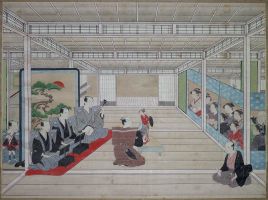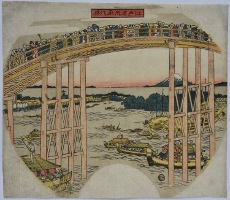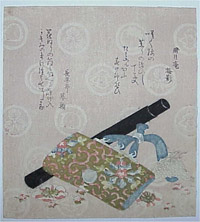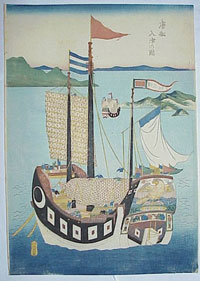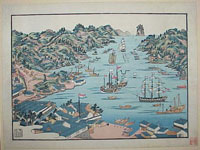ANONYMOUS (Mid to late 19th century)

Click here to view image full size.
A fine original painting in muted tones on silk, 43.75 x 16.5 in; 111.2 x 41.9 cms. Shows a vengeful female ghost (yurei) emanating from a ball of fire. She wears a plain white kyokatabira (funeral robe), has long unkept hair and her claw-like hand clutches her skeletal chest. Yurei-zu reached a peak of popularity in the 19th century, there being a seemingly insatiable demand from the public for stories of ghosts, demons and the supernatural reflected in popular fiction, Kabuki drama and art in general. These ghost paintings were often not signed: This one bears two seals reading “surpassing lotus” and “happy and heaven.” In very good condition with the surrounding mount: hashira and ichimonji areas painted in imitation of silk (kaki byoso) and the image overlapping these areas.
Status: Available
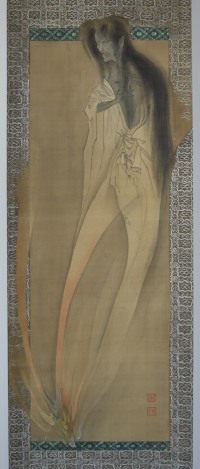
Click here to view image full size.
ANONYMOUS (Late 18th century)
Click here to view image full size.
An Uki-e, “floating picture” painting showing an interior with a puppet performance taking place. A puppeteer manipulates a female puppet in the centre, behind him two gidayu narrators and a shamisen player. A male puppet is being held behind a screen. Ladies behind a screen at right enjoy the drama. In fact, a male individual at the back seems overcome by emotion with a hanky to his face. The architecture is represented using one-point perspective, a style which made its way to Japan in the 1740’s from the West via China. (Interestingly the artist has got the perspective wrong on the screen at right.) This genre of painting – invariably unsigned – always shows interior or semi-interior views with banquets or, as here, puppet performances. Full colour on paper, 17 x 23 in; 43.2 x 58.5 cms. Minor marks, although good condition for this kind of painting.
Status:
Available
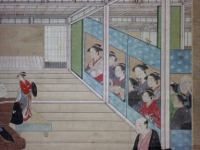
Click here to view image full size.
Anonymous (c. 1810)
Click here to view image full size.
An uncut ukie fan print, Edo meisho Eitaibashi, “Eitai Bridge, Edo.” Published by Ibaya Sensaburo, c. early 1800s. Possibly by Utagawa Kunimitsu or Utagawa Kunitora and quite possibly the only recorded impression.
Very good impression and colour. Slight corner soil, otherwise good condition.
Status: Sold
Anonymous (1821)
Click here to view image full size.
A still life from a set of six prints for the Iwagaki Club: Iwagaki-ren rokuhira no uchi. Shows a tobacco pouch, telescope and snake netsuke (for snake year 1821). There appear to be at least three states of this lovely surimono.
Fine impression and colour with gold and silver on the pouch. Minor rubbing, otherwise very good condition.
Status: Sold
ANONYMOUS
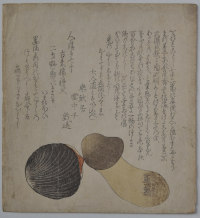
Click here to view image full size.
An unusual and rare surimono showing a matsutake, pine mushroom, and an akagai, red clam. Obvious sexual connotations due to their similarity to the human anatomy. The inscription is enigmatically signed Master In-The-Clouds or Humourously related by the Master who is relaxing and drinking while living in the clouds. With a reference to the Chinese immortal sage Yunzhongzi. Surimono were usually issued by poetry clubs or for specific occasions, although individuals also commissioned them. They could employ every artifice available to the printers and engravers: metal powders, mica, blind-printing and burnishing, and were printed on the best, thick hosho. They were not issued in large numbers as conventional Ukiyo-e and are usually of a smaller format.
Very good impression and colour. Slight soil, otherwise very good condition.
Status: Sold
Anonymous NAGASAKI-E
Click here to view image full size.
A Chinese ship entering the harbour. A rare print published by Yamatoya c1810s. Other impressions illustrated in: Nagasaki Prints And Early Copperplates, Masanobu Hosono, pl.33, p.55 and A Collection Of Nagasaki Colour Prints And Paintings, H.N.Mody, pl.87.
Very good impression, colour and condition.
Status: Sold
Anonymous (c. early 1800’s)
Click here to view image full size.
A bird’s-eye panorama of Nagasaki harbour. These views are the most remarkable of the Bunkindo productions demonstrating linear perspective and, when early impressions as here, showing the use of block and stencil printing. The only illustrated example I have catalogued is in the Tokyo National Museum illustrated in Nagasaki Prints and Early Copperplates, Masanobu Hosono, Kodansha, 1978, pl. 27, p. 51. Ex Prof. Boxer collection (his seal bottom right corner). Large oban: 13 by 17 inches; 33 by 43 cms.
Exceptional impression and condition for this genre of print, with large margins. Fine.
Status: Sold
